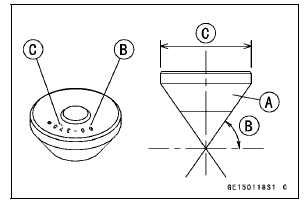

1. This valve seat cutter is developed to grind the valve for repair. Therefore the cutter must not be used for other purposes than seat repair.
2. Do not drop or shock the valve seat cutter, or the diamond particles may fall off.
3. Do not fail to apply engine oil to the valve seat cutter before grinding the seat surface. Also wash off ground particles sticking to the cutter with washing oil.
NOTE
Do not use a wire brush to remove the metal particles from the cutter. It will take off the diamond particles.
4. Setting the valve seat cutter holder in position, operate the cutter in one hand. Do not apply too much force to the diamond portion.
NOTE
Prior to grinding, apply engine oil to the cutter and during the operation, wash off any ground particles sticking to the cutter with washing oil
5. After use, wash it with washing oil and apply thin layer of engine oil before storing.
Marks Stamped on the Cutter
The marks stamped on the back of the cutter [A] represent the following.
60¬į ........................... Cutter angle [B]
37.5  .......................
.......................
Outer diameter of cutter [C]

 Valve Seat Repair
Valve Seat Repair Operating Procedures
Operating ProceduresCheck 2-2: Fuel Level Warning Inspection
Remove:
Fuel Tank (see Fuel Tank Removal in the Fuel System
(DFI) chapter)
Connect the resistor(s) [A] (about 50 to 100 Ω) between
the fuel pump connector terminal [B] of the main harness
side and the battery negative (‚Äď) terminal [C] as shown.
Turn the ignition switch ...
Ball Bearing and Needle Bearing
Do not remove pressed ball or needle unless removal is
absolutely necessary. Replace with new ones whenever
removed. Press bearings with the manufacturer and size
marks facing out. Press the bearing into place by putting
pressure on the correct bearing race as shown.
Pressing the incorrect ra ...
Coolant Level Inspection
Situate the motorcycle so that it is
perpendicular to the ground.
Check the coolant level through the
coolant level gauge on the reserve
tank located to the left of the engine.
The coolant level should be between
the ‚ÄúF‚ÄĚ (Full) and ‚ÄúL‚ÄĚ (Low) level lines.
A. Reserve Ta ...